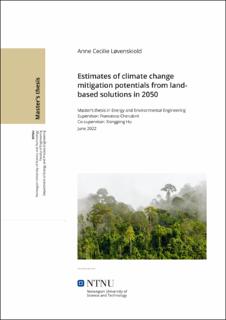| dc.contributor.advisor | Cherubini, Francesco | |
| dc.contributor.advisor | Co-veileder: | |
| dc.contributor.advisor | Hu, Xiangping | |
| dc.contributor.author | Løvenskiold, Anne Cecilie | |
| dc.date.accessioned | 2022-10-12T17:20:17Z | |
| dc.date.available | 2022-10-12T17:20:17Z | |
| dc.date.issued | 2022 | |
| dc.identifier | no.ntnu:inspera:110284204:23518687 | |
| dc.identifier.uri | https://hdl.handle.net/11250/3025720 | |
| dc.description.abstract | Identifisering av land dedikert til avlinger for bioenergi og en estimering av biomassens potensiale for forhindring av klimaendringer er nødvendig for å utvikle strategier for å dempe den globale oppvarmingen. Denne studien er en scenarioanalyse av de dedikerte områdene i 2050 ved hjelp av databaser for å identifisere arealet og vekstutbytte. Det identifiserte området er mellom 1.95 og 13.80 Mha og kan gi mellom 30.10 og 178.00 Mt tørr biomasse årlig. De evaluerte mulighetene i denne studien er naturlig gjenvekst og muligheten for å bruke biomassen til bioetanol, bioenergi med karbonfangst og lagring (BECCS), biokull kombinert med CHP og e-methanol. Alle strategiene viser seg å ha et negativt utslippspotensiale i minst ett scenario, men de totale livssyklus utslippene er sterkt avhengig av utslippene som følger av energibehovet til prosessene. Det største potensialet får man ved å bruke BECCS i scenario SSP4-RCP3.4 på -257 Mt CO_2 yr^(-1) . På grunn av geografiske forskjeller i potensiale for avlinger og naturlig gjenvekst, vil den optimale fordelingen mellom BECCS og naturlig gjenvekst føre til et potensiale av -281 Mt CO_2 yr^(-1) in SSP4-RCP3.4. Avhengig av scenario kan denne kombinasjonen føre til et utslippsredusjojnspotentiale på mellom 0.23 og 1.3 prosent av de globale utslippene i 2050. Denne studien viser viktigheten av å velge den riktige strategiene for å utnytte de begrensede landområdene i fremtiden. Den legger også et sammenlikningsgrunnlag for de teknologiske løsningene ved å legge de samme premissene for alle strategier. Den fjerner dermed barrierer fra den eksisterende litteraturen og bidrar til muligheten for robust og informert ressursforvaltning. | |
| dc.description.abstract | Identifying cropland dedicated to energy crops and estimating the potential given by the management of these, is essential for developing climate change mitigation strategies. This study is a continuation of the project work carried out fall 2021 and provides a scenario analysis of the dedicated land in 2050, using databases to identify the area and potential yield in three scenarios. The identified area ranges from 1.95 to 13.80 Mega hectares and can provide from 30.10 to 178.00 Mega ton dry mass annually. From the yield and area available, this study evaluates natural regrowth and the possibility of using second-generation energy crops for bioethanol, bioenergy with carbon capture and storage (BECCS), biochar with combined heat and power, and e-methanol. All solutions are shown to reach net negative emissions in at least one scenario; however, the life cycle performance of some technologies, especially e-methanol, strongly depends on the emissions from the energy source. The most significant climate change mitigation potential of -257 Mt CO_2 eq yr^(-1) is reached using BECCS in scenario SSP4-RCP3.4. Due to spatial differences in natural regrowth potential and crop yield, optimal management comes from combining BECCS with natural regrowth in all scenarios, which reaches -281 Mt CO_2 eq yr^(-1) in SSP4-RCP3.4. Dependent on the scenario, this combination can remove between 0.23 and 1.3 percent of the global anthropogenic emissions in 2050. Despite some limitations from dependency on the databases and the simplification of using global average values of energy supply emissions, this study shows the importance of choosing the right management option for the cropland dedicated to second-generation bioenergy crops in the future. It also lies a foundation that enables comparison of the technologies and strategies on the same premises, eliminating barriers in previous literature. This can contribute to more robust and informed land management in the future. | |
| dc.language | eng | |
| dc.publisher | NTNU | |
| dc.title | Estimates of climate change mitigation potentials from landbased solutions in 2050 | |
| dc.type | Master thesis | |
